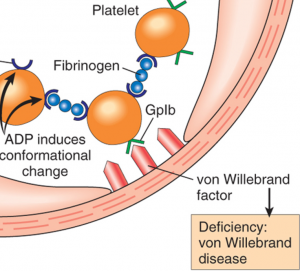
Category: Haemolymphatic
Gene: VWF1,2 & 3 on Chromosome 27
Variant Detected: Base Substitution of C>T , Base Substitution of A>G, Deletion of C, respectively.
Severity: Range from 2 to 5. Has a potential of high degree of severity and may causes a decreased quality of life and life expectancy.
Mode of Inheritance: Types 1 – Autosomal Recessive with Incomplete Penetrance
Types 2 & 3 – Autosomal Recessive
Overview: Von Willebrand disease (vWD) is the most common inherited bleeding disorder in dogs that results from a quantitative or qualitative defect in von Willebrand factor (vWF).
Three clinical types, 1, 2, and 3, have been described with Type 1 being the most common. In this type there are variably reduced levels of structurally normal von Willebrand factor. It has been reported in over 60 breeds, as well as mixed breed dogs. Some breeds are affected from birth, while others may not be affected until adulthood, or even middle age. DNA tests are available for relevant breeds, but some dogs that test “positive” may have severe disease, while others may never develop any bleeding tendency. Type 2 disease is a fairly rare recessive disorder, its another form of functionally abnormal vWD. Type 3 is the most severe form of the disease, it is inherited as an autosomal recessive trait, and affected individuals have no detectable vWF in their blood (quantitative vWD shortage).
Diagnosis can be aided by a von Willebrand factor assay, which expresses the level of von Willebrand factor as a percentage. Levels of von Willebrand factor are less than 50% in affected animals, but animals have an increased risk of haemorrhage (i.e. abnormal bleeding tendency) when levels are less than 25-35%. Severe bleeding tendencies are usually associated with levels less than 10-20% (depending on breed). Unfortunately Von Willebrand factor assays are quite variable within an individual, and can be affected by a number of factors, hence repeat testing can be necessary.
Signs of von Willebrand’s disease are generally those of abnormal bleeding or prolonged periods of bleeding. If undiagnosed, affected dogs can suffer life-threatening haemorrhage at times of routine surgery or after a traumatic event.
Treatment can often be required with blood, plasma or cryoprecipitate transfusions. It is generally recommended to at least test bleeding times prior to routine surgery in affected animals or breeds with a high incidence of the disease (e.g. the Doberman) and have appropriate transfusion products available in case of a bleeding episode.
For Research Citation(s): and Associated Breed(s): See individual disease pages on Orivet.com

